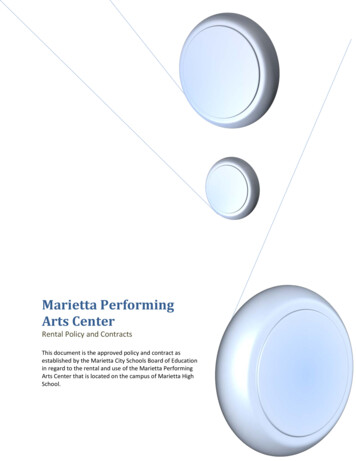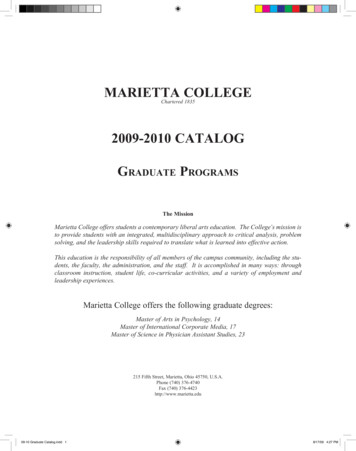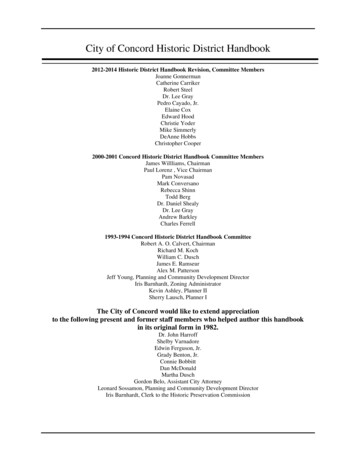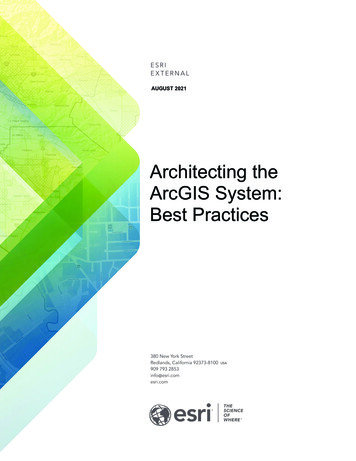
Transcription
1Marietta Pennsylvania Historic District&The Susquehanna National Heritage Area DesignationArcGIS Story MapKyle C. Cappucci, Class of 2022Elizabethtown CollegeJean-Paul Benowitz, Faculty MentorDirector of Student Transition Programs and Prestigious Scholarships & FellowshipsSummer Scholarship, Creative Arts and Research Projects (SCARP)Landmark ConferenceThursday 11 July 2019
2Table of ContentsAbstract 3Introduction . 3Local Historical Figures 4Historic Preservation Initiatives 8History of Marietta, Pennsylvania . 10National Historic Trust for Preservation: “This Place Matters!” . 17Bibliography . 18Appendix A: Section 106 Review Purpose and Process . 21Appendix B: National Designation Process . 25Appendix C: This Place Matters and National Treasure . 29Appendix D: Our This Place Matters Sites in Marietta . 30
3ABSTRACTIn the spring semester 2019, Honors students enrolled in Professor Jean-Paul Benowitz’s course, HonorsHistory 201 Elizabethtown History: Campus and Community, engaged in a Community Based Learning project,a collaboration between Elizabethtown College and RiverStewards, Inc., conducting research to contribute to theSusquehanna Heritage, Inc.’s nomination of the Susquehanna Riverlands as a National Heritage Area. A NationalHeritage Area designation will give the Susquehanna State Heritage Area access to federal funding and assistancefrom the National Park Service. The students conducted NHPA Section 106 Reviews of historically significantproperties in the Marietta Historic District and the Chickies Historic District. The students published theirfindings online through an ArcGIS map. The students presented their findings at Scholarship and Creative ArtsDay (SCAD) at Elizabethtown College on Tuesday 16 April 2019 and at Marietta Day on Saturday 11 May 2019in Marietta. One of the students in the class, Kyle C. Cappucci, expanded the project for Summer Scholarship,Creative Arts, and Research Projects (SCARP) in the summer of 2019. Cappucci broadened the CommunityBased Learning project to include Marietta Restoration Associates, Inc.; RiverStewards, Inc.; Rivertownes PAUSA, Inc.; and Susquehanna Heritage, Inc. Cappucci expanded the scope of the map beyond historicalsignificance to illustrate the contemporary significance of Marietta. Cappucci presented his scholarship to theMarietta Borough Council meeting on Tuesday 9 July 2019 and to the general public at the Marietta CommunityHouse on Wednesday 17 July 2019. His presentations entitled: “Putting Historic Marietta on The Map: ThisPlace Matters!” illustrated how the scholarship by the Honors students at Elizabethtown College can bringpositive attention to the Marietta Historic District, the Chickies Historic District, and the Northwest LancasterCounty River Trail. To this end, Cappucci suggested the Marietta Restoration Associates, Inc. take the lead inlaunching a historic preservation awareness campaign created by the National Trust for Historic Preservation,called “This Place Matters!”INTRODCUTIONPeople who walk, run, jog, hike, bike, cross-country ski, kayak, canoe, and boat through Marietta,Pennsylvania make use of the Northwest Lancaster County River Trail. “This multi-purpose public recreationtrail, created in 2007 along the Susquehanna River, is approximately fourteen miles long, spanning fivemunicipalities at the northwestern edge of Lancaster County.”1The trail connects the historic river towns of Columbia, Marietta, Bainbridge, and Falmouth. “The trailfollows the route of the historic Pennsylvania Mainline Canal and uses some of the original towpath remainingalong the corridor.”2 This provides ample opportunities to interpret historically significant architecture andindustrial archaeological remains such as abandoned canal locks; iron furnaces, railroad lines, and quarries.When people step off the trail to explore Marietta, they find a very quiet atmosphere showcasing excellentexamples of historic architecture. It is difficult for visitors and new residents to imagine this river town playedsuch an important role in the lumber and pig iron industries during the nineteenth century. Hard to believe fromthe First World War through the Vietnam War era Marietta was a major military supply depot and nationaltransportation center.LMS Commercial Real Estate. “Grace Plateau Lodge 6 Brochure” lms-pma.com /Brochure.pdf (accessed May 21, 2019).2Marietta, PA. “Lancaster Northwest River Trail” marietta-pa.com https://marietta-pa.com/map/river-trail/ (accessed May 21, 2019)1
4LOCAL HISTORIC FIGURESA vibrant river town playing an important role in industry and transportation also brought people fromvarious ideological backgrounds together. The exchange of ideas took place in classrooms of private and publicacademies, the Marietta Lyceum in the 1830s, the Libhart-Marietta Museum of the 1840s, and the educationalprogramming of the Marietta Community House for the past century. University of Pennsylvania ProfessorSamuel Stehman Haldeman3 (1812-1880) scientist and philologist from Bainbridge gave lectures and Mariettanative son artist John Jay Libhart4 (1806-1883) exhibited his paintings illustrating his research in the naturalsciences.Marietta is home to the national corporate headquarters for Donegal Mutual Insurance Company,established in 1889; GlaxoSmithKline the successor of Dr. H. M. Alexander5 (1851-1903) and Company akathe Lancaster County Vaccine Farm, created in 1882, the first commercial biological laboratory in the UnitedStates addressing smallpox; and Armstrong World Industries ceiling manufacturing plant. Indeed, MillersvilleUniversity, formerly Millersville State Normal School, was opened in 1855 by James P. Wickersham6 (18251891), first superintendent of Lancaster County Schools, formerly the principal of the Marietta Academy.Colonel John Duffy7 (1771-1836) emigrated to Marietta from Donegal Ireland where he was a memberof the Light Horse Cavalry. He was one of the key land speculators who laid out Irish Town in Marietta. Hebuilt the Marietta and Lancaster Turnpike, another turnpike connecting Elizabethtown to the Susquehanna River,and the road from Carlisle to Baltimore through York Springs and Gettysburg.Colonel James Duffy8 (1818-1888) was a prominent Marietta business leader in the cultivation oftobacco, the lumber industry, manufacturing, and transportation. During the Civil War he managed thetransportation of supplies to military outposts in the Western United States for which he was granted the rank ofColonel. In 1875 Governor John F. Hartranft (1830-1889) appointed Colonel Duffy Commissioner of Fisheriesfor Pennsylvania.Dr. Samuel Huston9(1792-1865) practiced medicine in Marietta moving there during the War of 1812.He owned warehouses and was engaged in transportation business along the Susquehanna River and thePennsylvania Canal. In the election of 1828 he opposed Andrew Jackson in favor of incumbent John QuincyAdams. Like is close friend Congressman Thaddeus Stevens, he was a member of the Anti-Masonic Party,employed fugitive slaves in Marietta, and helped many travel along the Underground Rail Road. He was the AntiMasonic party’s candidate for Pennsylvania State Senate but was defeated. His defiance of the 1850 FugitiveSlave Act caused him to be unpopular in Marietta.Captain Samuel D. Miller (1791-1872) a tailor who served in the War of 1812 before opening WalnutHall Clothing Store. During the Civil War he was Captain of the local militia company the “Marietta Blues” andwas elected Burgess (Mayor) of Marietta. His nickname was “Old Soldier.”Henry Miller Watts10 (1805-1890), an attorney born in Carlisle, Pennsylvania, Dickinson College classof 1824, was the son of David Watts and the grandson of Revolutionary War generals on both sides of his family.In 1827, after practicing law in Pittsburgh, Watts was appointed a deputy Attorney General for Pennsylvania. InHaldeman Mansion Preservation Society. “Samuel Steman Haldeman” hadleman-mansion.org an.htm (accessed May 21, 2019).4Marietta Sesquicentennial Souvenir Booklet (Marietta, PA, August 4, 1962,) 53.5Ibid, 42.6Ibid, 47.7Mowry, Millie, PA-Roots, “Duffy, James., Col.,” pa-roots.org http://www.pa-roots.org/data/read.php?31,104386 (accessed May 21,2019).8Ibid.9Hallum, Charley Hal Houston, “A History of the Hallum Family” (C.H.H. Hallum, 1979).https://books.google.com/books/about/A History of the Hallum Family.html?id Wm0rHAAACAAJ (accessed May 21, 2019).10Dickinson College Archives & Special Collections. “Henry Miller Watts (1805-1890)” u/people/henry-miller-watts-1805-1890 (accessed May 21, 2019).3
51835, he was elected as a state representative from Allegheny County, served three one-year terms, and in 1838returned to private practice in Philadelphia.In 1841, President Harrison named him as United States Attorney for eastern Pennsylvania. From 18571862 he lived in Paris to enroll his children in French schools. In 1862 he became one of the fifty foundingmembers of the Union League of Philadelphia, a patriotic club established to support President Lincoln, still inexistence today, on Broad Street. From 1863-1868 he lived in Germany where his eldest son studied mining andengineering in Dresden.In July 1868 Watts was appointed the United States ambassador to the Austrian Empire. This post wasvacant since the recall of the previous envoy the summer before and in the interim the Senate had rejected sevenof President Johnson's nominations. The U. S. Senate finally accepted Watts in August 1868 and he arrived inVienna on 25 September 1868. He served less than a year, however, because he was recalled in June 1869 whenthe new President Grant filled his place with John Jay. Returning to Pennsylvania, Watts devoted himself to hispractice and his business interests in pig iron in Marietta.Ethelbert Watts11 (1846-1919) was the second son of United States Minister to Austria Henry MillerWatts and Anna Maria Schoenberger. He was a great-grandson of Revolutionary War brigadier-general FrederickWatts, and also of lieutenant colonel Henry Miller (1751–1824), who led colonial army units in the siege ofBoston and the engagements of Long Island, White Plains, Trenton, Princeton, Brandywine, Germantown andMonmouth. He was the nephew of Frederick Watts, President Ulysses S. Grant's Commissioner of Agricultureand the first president of the board of trustees of Penn State University.He was born in Philadelphia, educated in Paris, then at the University of Pennsylvania. In 1863, he enlistedas private in Company D, Thirty-second Regiment, Pennsylvania Volunteer’s Emergency Militia Infantry,performing duties in the Department of the Susquehanna. After graduating from Penn, he studied at the RoyalSaxon School of Mines, Freiberg, and Saxony. In 1871, he married Emily Pepper, daughter of Dr. William Pepper,Sr. and sister of Dr. William Pepper, Jr. of Philadelphia. They had four children among them was U.S. Navy RearAdmiral William Carleton Watts. Emily Watts died in 1885 and in 1895 he married Katharine L. Gregg. Theyhad two children among them was Ethelbert Watts, Jr. (who became an intelligence officer during World War IIand military liaison officer during the Cold War). Returning to Philadelphia, he was engaged in the pig ironbusiness in which his father had extensive interests. Henry M. Watts & Sons became the owners of MariettaFurnace No. 2.In March 1896, he entered the U. S. Foreign Service. President Grover Cleveland appointed him to hisfirst post at Horgen, Switzerland. The next year he was appointed vice and deputy consul-general at Cairo, Egypt,where he was in charge during the Spanish–American War. Before leaving this post, he was decorated by theKhedive with the Order of Osmanieh. During the next two years he was consul-general at Kingston, Jamaica,and from there went to Prague, Bohemia. While at Prague, he accepted the position of consul-general at St.Petersburg. He served there from 1903 to 1907 during the Russo-Japanese War and the Revolution of 1905. Inrecognition of his services in protecting Japanese interests in Russia during the war, he was decorated by theEmperor of Japan with the Order of the Rising Sun and the Sacred Treasure. From April 1907 to April 1917, hewas consul-general at Brussels, Belgium. When the U. S. entered the First World War all-consular offices inGerman-occupied Belgium were discontinued, and he was ordered home. He was acting consul at Halifax, NovaScotia. In May 1918, he was appointed consul-general at Hamilton, Bermuda. His great-granddaughter is actressElizabeth McGovern best known for play the role of wife of the Earl of Grantham on the PBS television showDownton Abbey.Barr Spangler12 (1822-1922) in 1922, at the time of his death at age 100, was noted as being the oldestactive bank president in the United States. Spangler, a Marietta native son, spent his entire life in LancasterCounty. At age fourteen he began employment as a clerk in a dry goods store, he was given control of this businessRevolvy. “Ethelbert Watts” revolvy.com https://www.revolvy.com/page/Ethelbert-Watts (accessed May 21, 2019).The Strangest Names in Political History. “Barr Spangler (1822-1922)” 22-1922.html (accessed May 21, 2019).1112
6while still a young man and was later joined by his elder brother William, his son Charles, and a nephew, J. BarrSpangler. While still the proprietor of the B. and C. S. Spangler firm, he became a director of the First NationalBank of Marietta and continued in this role for fifty-nine years, terminated only by his death in 1922.A prominent figure in the Prohibition Party during the 1860s-1870s, Spangler made his first attempt atelective office in 1869, when he ran on the Prohibition or 'Temperance" Party ticket for Pennsylvania StateAuditor General. He polled only 3,186 votes, compared to Republican David Stanton, who won the election with284,097 votes. In 1872 Spangler made another attempt for state auditor, running once again on the prohibitionplatform. When the votes were tallied on election day he polled only 1,260 votes, placing a distant third in a fieldof three candidates. Republican candidate Harrison Allen (1835-1904) emerged the victor with over 350,000 votesand went on to serve as state auditor from 1872-1875. In 1885 Spangler was the Prohibition candidate for StateTreasurer of Pennsylvania but again came up short in the vote count, garnering only 627 votes to Matthew S.Quay's winning total of 5,338. Following his defeat, Spangler continued to be a prominent figure amongst theranks of the Prohibition Party, even being selected as a delegate to the State Prohibition Convention in 1887. Inaddition to his numerous candidacies, Spangler served as the Treasurer of the Pennsylvania State TemperanceUnion for a number of years.Barr Spangler celebrated his 100th birthday on 13 January 1922 and was honored at a dinner celebratinghis life. He received a congratulatory telegram from President Warren Harding and Pennsylvania GovernorWilliam C. Sproul.Captain Judge Jacob Grosh13 (1776-1860) native son of Marietta was nominated 1811 for thePennsylvania House of Representatives. He was reelected to the Legislature for the sessions of 1813, 1814, and1816. In 1818 he was elected to the Pennsylvania State Senate, and served four years, making his legislativeservice eight years, four in the House and four in the Senate. After, he served nine years as a judge of the LancasterCounty Court of Common Pleas. Grosh never returned an escaped slave to bondage, even after Fugitive SlaveAct of 1850 was enacted.Major John Huss14 native son of Marietta served in the Pennsylvania State legislature from 1823-1824.Publisher of Marietta’s newspapers the Pilot and the Pioneer, Huss was the commander of the Donegal Rangers.In 1814 when the British burned Washington, D. C. and threatened Philadelphia, he joined Captain Judge JacobGrosh (1776-1860) in raising a company of volunteers called the Marietta Grays of which Huss served as firstlieutenant.Brevet Colonel Emanuel Dyer Roath15 (1820-1907) Justice of the Peace at Marietta settled there in 1852working in the lumber industry. His father, Jacob, was a tailor by trade and was a member of the company whichescorted General Lafayette from Paoli to Lancaster, on the occasion of his second visit to the United States. AtCamp Curtin, Harrisburg, Roath was authorized by Governor Curtin to raise a company of volunteers for servicein the Civil War, the result being he enrolled Company E, 107th P. V. I., of which he was commissioned Captain,and he served until 19 March 1865, when he was mustered out at Washington, D. C., being later breveted majorby President Andrew Johnson, and breveted lieutenant colonel and later colonel by Governor John W. Geary.After the war he returned to Marietta and officiated as a magistrate until October, 1867, when he was sent to theState Legislature by the Republican Party. In 1858 Mr. Roath was first elected as the representative of his districtin the State Legislature and served one term; in 1868 he was again elected to this body, and again served oneterm. He was appointed brigade quartermaster of a brigade of the Lancaster county militia: by General JacobGross. For seven years he commanded a volunteer company out of Maytown, called "The Jackson Fencibles,"infantry.Farrell, Cathy, Genealogy. “Grosh Family” genealogy.com osh/58/ (accessedMay 21, 2019).14Archive.org. “History of Lancaster County, Pennsylvania: with biographical sketches of many of its pioneers and prominent men”archive.org historyoflancast02elli djvu.txt (accessed May 21, 2019).15Archive.org. “History of Lancaster County, Pennsylvania; containing biographical and genealogical sketches of prominent andrepresentative citizens and many of the early settlers” 2998/cu31924028852998 djvu.txt (accessed May 21, 2019).13
7Vice Admiral Charles Horatio “Soc” McMorris16 (1890-1954) was on the staff of Admiral HusbandKimmel at the time of the Japanese attack on Pearl Harbor and was made chief of staff for admiral Chester Nimitzthroughout the Second World War. His wife Elizabeth McCorkle Case McMorris (1890-1967) a native ofMarietta was a cousin to Elizabetht McCorkle Fitzgerald Hiestand (1873-1965). The McMorris family summeredin Marietta and retired here.Henry B. Cassel17 (1855-1926) native son of Marietta was a Republican member of the U. S. House ofRepresentatives from Marietta. A descendent of Henry Cassel one of the founders of Marietta, he attended theColumbia Classical Institute. His family’s lumber business P. Cassel was established in 1807 arguably the oldestin this local industry. In 1881 he was a member of the Republican Lancaster County Committee and chairmanin 1883. He was a delegate to the 1896 Republican National Convention before serving from 1898-1900 in thePennsylvania State House of Representatives. While in the U. S. Congress he served as Chairman of the HouseCommittee on Accounts. In 1909, during the sixtieth congress, he was convicted of fraud related to theconstruction of the Pennsylvania State Capitol. From 1909-1926 he returned to Marietta engaged in business asa manufacturer and contractor.David S. Hickernell18 (1959) native son of Marietta is a Republican member of the Pennsylvania Houseof Representatives for the 98th District elected in 2002. He currently sits on the House Agriculture and RuralAffairs, Local Government, and Transportation Committees. He is a member of St. Peter’s Catholic Church inElizabethtown, where he has served in various leadership positions, including president of the church council. Hegraduated from Donegal High School in 1977 and graduated from Elizabethtown College in 1983.He joined the staff of the House Republican Caucus as a legislative assistant after graduating from college.He worked several positions in the House Republican caucus, including as a legislative assistant, as Director ofthe House Policy Committee, as Executive Director for the Majority Whip’s Office, and as Executive Assistantto the Majority Appropriations Chairman. He was elected to the Clerk of Courts in Lancaster County,Pennsylvania. During his tenure in the Clerk of Courts Office, he instituted several positive reforms making thecriminal court records more accessible and open to the public.He was first elected in 2002 to represent the 98th legislative district in the Pennsylvania House ofRepresentatives. He was Chairman of the House Professional Licensure Committee for the 2019-20 session. Healso served as a member on both the House Education Committee and the House Rules Committee. He served asChairman of the House Education Committee, and Chairman of the Tourism and Recreational DevelopmentCommittee. During his first term as a legislator, he saw three of his bills become law. Eleven of his primesponsored bills having been signed into law. In 2005, Hickernell authored House Bill 1579 which was signed intolaw as the Resource Family Care Act. In 2015, his Activities and Experiences for Children in Out-of-HomePlacement Act (House Bill 477) was signed into law. In 2014, Hickernell was approached by a constituent whosechild had been killed by a drunk driver. She asked and Hickernell authored legislation to change state law torequire Responsible Alcohol Management Training for any seller or server of alcohol in the Commonwealth.Mothers Against Drunk Drivers, the national group fighting drunk driving and underage drinking, namedHickernell Legislator of the Year for his efforts. Hickernell was able to get Responsible Alcohol Training signedinto law.Robert V. Cresswell (1903-1991) and his wife Mary W. Cresswell (1909-1998) were key leaders in thehistoric preservation movement in Marietta in the 1960s. Dr. Cresswell was president of the Marietta RestorationAssociation, president of the Marietta Lions Club, and for seven years he served on the Marietta Borough Council.He earned a bachelor's degree in 1928 and a master's degree in 1934 from Penn State University. He earned adoctorate in education in 1950 from the University of Pittsburgh. At Penn State University, Cresswell was amember of Sigma Pi, and a member of Phi Delta Kappa at Pittsburgh. His career spanned over forty years inteaching and secondary school administration in the Pittsburgh schools. He was the director of the Middle StatesWikipedia. “Charles McMorris” wikipedia.org https://en.wikipedia.org/wiki/Charles McMorris (accessed May 21,2019).Wikipedia. “Henry B. Cassel” wikipedia.org https://en.wikipedia.org/wiki/Henry B. Cassel (accessed May 21,2019).18Revolvy. “David Hickernell” revolvy.com https://www.revolvy.com/page/David-Hickernell (accessed May 21,2019).1617
8Commission on Colleges and Secondary Schools. For one year he was professor of secondary education atElizabethtown College.Local architect, the late C. E. Urban, designed many homes in Marietta. Cassius E. Urban19 (1863-1939),a native son of Lancaster County, was the community’s leading architect from the 1890s through the 1920s. Bornin Conestoga Township, he descended from a long line of country carpenters. His family moved to LancasterCity in 1873 opening a planing mill on South Prince Street manufacturing window sashes, doors, and millwork.He graduated from Lancaster’s Boys High School in 1880, and then apprenticed as a draftsman at the E. L. Walterarchitectural firm in Scranton. In Philadelphia he worked as a draftsman for architect W. G. Hale. In 1886 hereturned home to Lancaster and opened a private practice.He designed over one hundred of Lancaster’s notable buildings including the Farmer's Southern Market(1888), Watt & Shand Department Store (1898), and the Greist Building (1924). His office was in the Woolworthbuilding on North Queen Street which he designed in 1899 for Frank Woolworth as a memorial to his first store.These iconic buildings define Lancaster’s historic past as well as its present urban context. His designs werestylistically eclectic, reflecting the influence of Queen Anne, French Renaissance, Gothic Revival, Beaux Arts,and Colonial Revival periods.His work forms a bridge between the Victorian Era and the Modern Age. Over the span of a forty-fiveyear career Urban’s designs included major commercial and public buildings, churches, hotels, schools, industrialbuildings, and private residences. Among those private residences was the mansion of Aaron Kreider in Palmyraand perhaps the Kreider Shoe Factory in Elizabethtown. Urban designed the private homes and department storesof the Watt and Hager families.Through membership in the Hamilton Club, Urban knew Milton Hershey and designed his Lancaster Cityhome and his estate High Point in Derry Church Township. Hershey hired Urban to design all of the mainbuildings in his community constructed between 1903 and 1926, including the Hershey Chocolate Companyoffices and factory (1903), Hershey Trust Company (1914), Community Building and Hershey Theatre (1915)and Convention Hall (1915).Today, Urban’s buildings are timeless contributions to our urban architectural heritage. How appropriatethis forward-thinking man in the life of Lancaster’s city and towns was himself named “Urban.” The architecturallegacy of Urban continues to enrich Lancaster’s unique historic character. His buildings illustrate the range ofhis abilities and the breadth of his skills.HISTORIC PRESERVATION INITIATIVESIn 1912 Marietta held celebrations commemorating its Centennial20 during September 4-6. Barr Spanglernoted in his historical address delivered on Wednesday 4 September how there were Europeans living in Mariettaas early as 1715, however; the year of the founding of the community was determined to be 1812. In 1962 duringAugust 4-11 Marietta held events celebrating the Sesquicentennial21 of the community. According to a localhistory published in a souvenir booklet, the year 1812 was chosen as the beginning of Marietta, because this iswhen a charter was granted by the Pennsylvania legislature to name the existing incorporated communities.Perhaps this is best, because the sesquicentennial coincided with a national movement concerned withhistoric preservation. In preparing for the celebration of two centuries of Marietta (although it should have beenthree centuries since the community was established as early as 1719) people realized the importance of historicpreservation for a place such as Marietta.The Marietta Restoration Associates, Inc. is a non-profit corporation chartered on 23 June 1965 “ topromote, encourage, and conduct the restoration, development, and preservation of the historical, cultural, andSnyder, John J., Susquehanna Monthly Magazine. “C. Emlen Urban: A Reconsideration” (Vol. 7, No.4, April 1982).Haas, Andrew J., Marietta’s Centennial Program (Marietta, PA: Press of the New Era Printing Company, September 1912).21Marietta Sesquicentennial Souvenir Booklet (Marietta, PA, August 4, 1962).1920
9aesthetic aspects of the Borough of Marietta ”22 “On 15 October 1966 President Lyndon B. Johnson signed intolaw the National Historic Preservation Act. The NRHP is the nation’s official inventory of historic districts, sites,buildings, structures, or objects worthy of preservation.”23In 1966 The Historic Preservation Trust of Lancaster County, “known colloquially as The PreservationTrust, is a non-profit corporation encouraging and facilitating historic preservation throughout Lancaster County.HPTLC maintains its own inventory of historic places in Lancaster County.”24In December 1966, the Marietta Restoration Associates, Inc. held its first annual Candlelight Tour ofHomes originally named “Christmas by Candlelight.”25 The event was organized to showcase the rich diversityof historically significant architectural styles in Marietta and to share the history of this community. “The annualtour of homes was inspired by the success of two-house tours in Marietta held on 13 May 1961 and 19 May1962.”26 In 1979 Marietta Restoration Associates initiates Historic Marietta Day to promote communityawareness for historic preservation.“Over half of Marietta has been designated as a National Historic District through three nominations: 18July 1978, 17 August 1984, and 28 December 2005.”27 “The most recent National Historic District incorporatesapproximately 600 acres bounded by the Susquehanna River, and Chickies Creek. Known as the ChickiesHistoric District this area preserves the ruins of the pig iron industry, the Pennsylvania Canal, the rail road, andrelated residential and commercial structures.”28Marietta has three structures listed individually as historic landmarks: The New Haven Counting House,the Linden House/Henry Cassel Mansion, and the Silk Mill Condominiums. Several homes are listed with theHistoric Preservation Trust of Lancaster County HPTLC, the Marietta Historic District MHD, and the ChickiesHistoric District CHD.The National Historic Preservation Act requires federal agencies to evaluate the impact of all federallyfunded/permitted projects on historic properties through a Section 106 Review. This NHPA review processmandates when federal agencies’ projects may affect historic properties (both those listed or eligible for inclusionin the National Register of Historic Places) must consider the effects on historic properties. “A Section 106Review involves four steps: (1) Initiation of the Section 106 Review (2) Identification of Historic Properties (3)Assessment of Adverse Effects (4) Resolution of Adverse E
University, formerly Millersville State Normal School, was opened in 1855 by James P. Wickersham6 (1825-1891), first superintendent of Lancaster County Schools, formerly the principal of the Marietta Academy. Colonel John Duffy7 (1771-1836) emigrated to Marietta from Donegal Ireland where he was a member of the Light Horse Cavalry.










